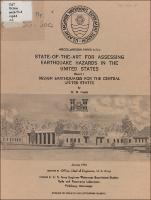Please use this identifier to cite or link to this item:
https://hdl.handle.net/11681/20918| Title: | State-of-the-art for assessing earthquake hazards in the United States. Report 1, Design earthquakes for the central United States |
| Authors: | Nuttli, Otto W. |
| Keywords: | Earthquakes Seismology Geology Central United States Design earthquakes Earthquake hazards |
| Publisher: | Soils and Pavements Laboratory (U.S.) Engineer Research and Development Center (U.S.) |
| Description: | Miscellaneous Paper Abstract: The earthquake risk problem in the Central United States, taken to be approximately the area east of the Rocky Mountains and west of the Appalachians, is discussed. The seismic history of the area is reviewed and is used to divide the area into various seismic regions. A design earthquake, defined as the largest earthquake that can be expected to occur within an area, is specified for each of the three seismic regions. Specification of the design earthquake is accomplished by giving ground displacement, particle velocity, and acceleration values in hard rock as a function of distance from the earthquake, for three particular wave frequencies. The results are presented in graphical and tabular form. A brief discussion of the effects of soil instability is included. The problem is of particular importance in the Mississippi and other major river valleys of the Central United States. |
| Rights: | Approved for public release; distribution is unlimited. |
| URI: | http://hdl.handle.net/11681/20918 |
| Appears in Collections: | Miscellaneous Paper |
Files in This Item:
| File | Description | Size | Format | |
|---|---|---|---|---|
| MP-S-73-1-Report-1.pdf | 7.21 MB | Adobe PDF |  View/Open |